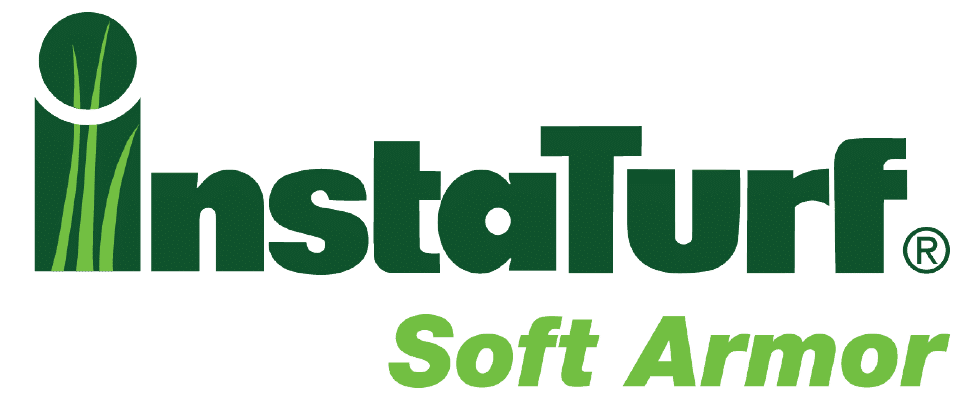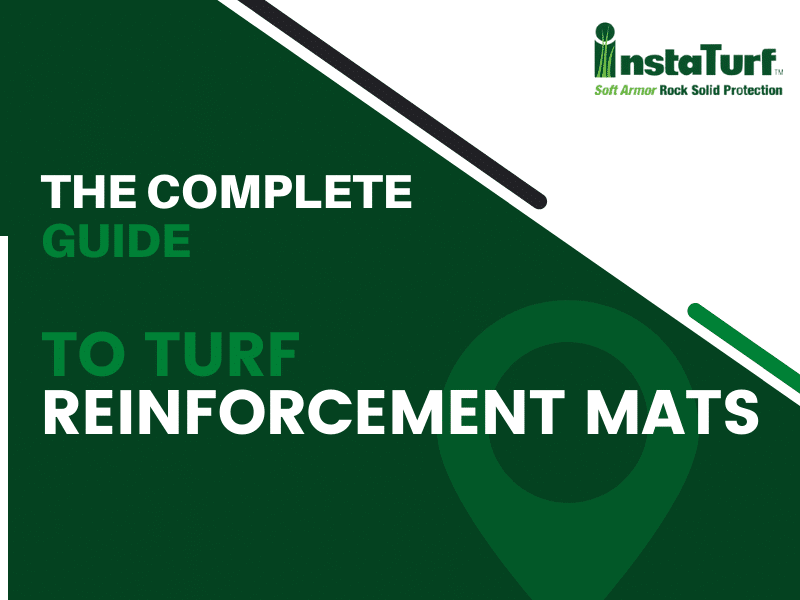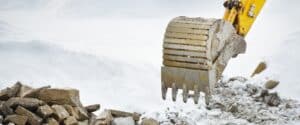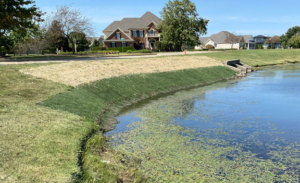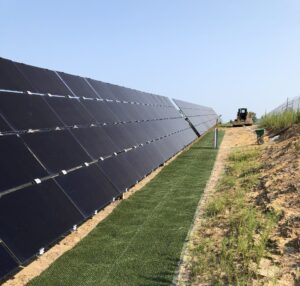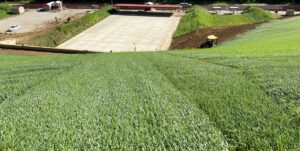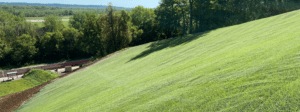Over the last century, many advancements have been made in the way we shape the world around us. Science and technology have enabled us to alter our surroundings more than ever before. However, as we expand and change the world around us, we are still susceptible to natural elements. Numerous industries, especially the construction, agricultural, and landscape industries, are faced with the challenges posed by soil erosion. In order for us to create what we want and protect the world around us, it is vital to look into erosion protection.
There are numerous erosion control measures that can help protect the soil surface. You have probably heard of tacking agents, landlok TRMs, and related products, suffice is to say that using a straw blanket or coconut blankets is no longer the only remedy available for soil erosion. Thankfully, we now have a variety of options when it comes to permanent erosion control. This guide is going to cover soft armor solutions, like turf reinforcement mats (TRMs) and other Rolled Erosion Control Products (RECPs) such as InstaTurf, in detail.
Before diving into TRMs, it is essential to consider if this is the right erosion control product for you. Controlling erosion will require a proper understanding of erosion and erosion processes. Doing so is vital for selecting adequate erosion control treatments.
Erosion
Most people think of soil as something solid and stable, which even inspires the saying “as solid as the ground we stand on.” Professionals such as agronomists, soil scientists, hydrologists, geotechnical and civil engineers will beg to differ. They are aware that there is a lot more to soil than meets the eye. Soil is always being affected in one way or another by the environment. If left to the elements, it is susceptible to erosion. Curb inlets are one of the most common and familiar ways in which soil is at risk of erosion because of exposure to damaging contaminants. Erosion is a natural geological process of wearing away the land’s topsoil by natural forces. The two main agents responsible for soil loss and transporting earthen materials are water and wind. The process can be broken down into three main parts – detachment, movement, and deposition. While this might not sound like a significant problem, erosion can create pollution and considerable changes in the soil surface of landscapes over time. This can undermine structures and roadwork.
Erosion control
Erosion control aims to stop both air and water erosion from taking place. It is widespread and most often implemented in agricultural land, coastal areas, riverbanks, land development, and construction sites. If these control measures are successful, they will limit or prevent surface runoff, preventing soil loss and potential water pollution. Erosion control is used in agricultural settings, urban environments, and natural areas. These measures have proven to be effective in reducing erosion potential by stabilizing soil and reducing raindrop impact and the velocity of running water. Vegetative reinforcement is something that occurs naturally within an untouched area of land but is often interrupted by farming, construction, or human interference. Erosion control in this sense aims to restore a naturally occurring process by artificial means. Subsurface drainage is another process that is affected by urban development and usually impacts natural areas when roads are built and asphalted. These roads have a dramatic effect on the way rainwater is spread across any given area of land. TRMs and Rolled Erosion Control Products (RECPs) provide a reliable erosion control solution by mimicking vegetative reinforcement and in doing so, protecting soil and water quality.
Principles of Erosion Control
When it comes to reducing erosion, certain established principles are followed for effective erosion control.
Lessen Erosive Forces and Increase Resistance
Erosion happens when erosive forces, such as water or wind working with gravity, are too great for the soil to resist. One of the first aims of erosion control is to reduce erosive forces as much as possible and increase resisting force.
Erosion Control and Sediment Control
If good erosion control is established, it lessens the need for sediment control. Preventing soil from running off is usually much more affordable and easier than removing soil once it is deposited elsewhere.
Shape Topology or Topography?
Shaping topography for our needs is a crucial factor in reducing erosion. Flatter and shorter slopes are worn away less and produce less sediment, compared to long and steep slopes. This principle can be practically applied in grading and shaping, which are methods for reducing runoff and establishing vegetation.
Reduce Soil Exposure
The more exposed soil is, the more it will be susceptible to erosion. Limiting soil exposure is one of the keys to preventing erosion. Water flowing onto unprotected soil should be diverted to prevent runoff. It is also beneficial to establish permanent vegetation over the soil to help protect it from runoff and splash erosion caused by rainfall. If soil is bare, it is best to install permanent erosion protection as soon as possible to avoid disturbing the soil surface.
Reduce the Velocity of Running Water
The velocity at which water flows over soil can dramatically impact the rate of erosion. In order to minimize erosion, it is best to keep runoff velocity as low as possible. This can be done by reducing the slope gradient, increasing the roughness of the soil surface, or protecting the soil with a high-roughness material.
Maintenance is Vital
When installing or implementing erosion protection, proper installation and maintenance of erosion control treatments are essential. Make sure to follow installation guidelines and/or applicable specifications for efficient use. Once put in place, conduct regular check-ups to ensure they are in place.
Types Of Erosion
A number of different factors cause erosion, and a different name classifies each. The numerous types of erosion are water erosion, wind erosion, gravity-caused erosion, ice-caused erosion, and chemical erosion. While it is essential to understand that there are different types, we are not going to be covering all of them in detail. This guide will focus on the control of water erosion.
Forms of Water Erosion
There are numerous ways that water erosion is visible on the soil. These are some forms of water erosion.
A Look Into Water Erosion
Water erosion is what most people associate with soil erosion. It is caused when soil is detached and transported by water caused by runoff, rainfall, melted snow or ice, and irrigation. For slopes, the most common forms of erosion are sheet, rill and gully erosion. The following factors influence the rate and extent of water erosion on slopes:
- Runoff and Rainfall
- Soil Erodibility
- Slope length and steepness
- Vegetation
Runoff and Rainfall
When it comes to flowing water, the greater the duration and intensity of flowing water, the higher the chance for erosion. In instances of falling water, such as rainfall, the soil surface is broken down and dispersed. Lighter soil material is easily carried away by runoff water. This can best be seen during short and intense thunderstorms. Runoff, on the other hand, occurs when there is too much water on a slope and water is unable to infiltrate the soil. This can be a result of soil compaction, freezing, or crusting, which, in turn, results in more surface runoff and erosion. Temporary erosion control is often installed on construction sites as a precaution, to avoid rainfall from lowering the water quality because of sediment. This type of sediment control is an effort to safeguard the soil and water in the surrounding area.
Soil Erodibility
Soil erodibility is best defined as a soil’s susceptibility to agents of erosion. The erodibility of a soil is determined by properties such as structure, clay minerals, soil organic matter, texture, soil retention properties, and soil transmission properties. Soil texture is the main characteristic that affects soil erodibility, but the structure, permeability, and organic matter also contribute. Another important factor to consider when determining soil erodibility is the terrain itself. Ground cover is vital in moderating the impact of erosion due to its ability to dissipate the energy of the soil erosion agents.
Slope Gradient And Length
Certain characteristics, such as the slope gradient, length, and shape of the terrain, all play an important role in erosion. Water flowing down longer and steeper slopes is more likely to cause erosion, due to the velocity it can generate. The greater and steeper any slope is, the more susceptible the land is to scouring and erosion.
Cropping and Vegetation
Soil that has little to no vegetative cover has a higher potential for soil erosion. Vegetative covers help protect the soil in a number of ways. Firstly, they act as protection against rainfall. The impact generated from raindrops can cause splash erosion. However, with good vegetative coverage, that impact is reduced. In addition to that, it also slows down runoff water and allows excess surface water to infiltrate the soil. The effect vegetative cover will have depends on the type, quality, and extent of the cover.
For drainage channels, stream banks, riverbanks, spillways, and outfall areas, the most common forms of erosion are channel and bank erosion. The primary erosive force impacting these areas of concentrated water flow is the tractive force or shear stress exerted on the soil surface by water flowing over it by gravitational pull. Factors affecting the amount of shear stress being exerted by water flow include the depth of flow and slope gradient of the surface upon which it flows. Calculating flow-induced shear stress in channelized flow is a fairly simple process using the following equation:
T = Y x D x S
Where T = Maximum Shear Stress in lbs/sf
Y = the unit weight of water (62.4 lbs/cf)
D = Depth of water flow (ft)
S = Bed slope gradient or energy line (ft/ft)
NOTE: Maximum permissible shear stress ratings are standard performance ratings for erosion control materials used in areas of concentrated water flow, such as drainage channels.
Erosion Control Products
There are numerous erosion control products available on the market. Most products aim to help prevent erosion from taking place and establish permanent vegetation on the soil. Vegetation is typically the most desired form of long term erosion protection, except in areas with standing water that may prevent its establishment, or where flow conditions are too extreme for either natural or reinforced vegetation to extreme Erosion control products can be divided into Hydraulic Erosion Control Products (HECPs), Rolled Erosion Control Products (RECPs), and Sediment Retention Fiber Rolls (SRFRs). Each group of products uniquely tackles erosion and sediment control. This guide will briefly look at hydro-mulching and wattles and focus more on rolled erosion control products.
Overview of HECPs and SRFRs
Hydraulic Erosion Control Products (HECPs)
HECPs are used for hydraulic seeding and hydraulic mulching. When it comes to HECPs, it is important to note the difference between hydromulching and hydroseeding. Hydroseeding is a term for applying seed using water. Hydroseeding on its own offers little to no protection to the ground until vegetation is established. Hydromulching is also seeding, but it includes the addition of mulch fibers, such as paper, wood or straw. With hydraulic mulches, germination and soil protection is improved. The mulch sits in place to provide erosion protection while vegetation is established. Hydraulic mulches can also be applied without seed as a form of temporary erosion protection. These products are sprayed onto larger areas to prevent soil erosion. One of the main drawbacks of many HECPs is that they don’t offer a high level of erosion resistance and can be washed away, requiring re-application.
Sediment Retention Fiber Rolls (SRFR)
Sediment retention fiber rolls are available as pre-manufactured units. They are shaped like tubes and are made up of various natural filler materials, including compost, straw, wood and coconut fibers. These tubes are installed on slopes and along job-site perimeters to slow down the velocity of water flow and trap sediment. The primary purpose of fiber rolls is sediment control. However, they can still help slow down runoff, minimizing rill and gully development and, in that way, help prevent erosion. They usually have a lifespan of 1 to 3 years and must be properly installed and maintained for effective use.
Rolled Erosion Control Products (RECPs)
RECPs are rolled out onto the soil surface and secured into place to reduce soil surface erosion. However, they are not one-size-fits-all products. Each RECP has its own benefits and limitations. Keep that in mind when selecting the right product for your specific applications. RECPs can be classified into:
Temporary Erosion Protection and Vegetation Establishment
- Mulch Control Nets (MCN)
- Open Weave Textiles (OWT)
- Erosion Control Blankets (ECB)
Permanent Erosion Protection, Vegetation Establishment and reinforcement
- Turf Reinforcement Mats (TRM)
RECPs are divided into temporary and permanent erosion control materials. Temporary materials are used on soil that is yet to establish a vegetative cover. Temporary methods can be organic (biodegradable), synthetic (photodegradable), or a mix of the two. Once permanent vegetation is established, temporary RECPs are designed to photo or biodegrade. If the natural vegetation cannot provide sufficient long-term erosion protection, then permanent RECPs are the solution. They are ideal for providing the necessary erosion control and vegetation reinforcement for various more severe flow conditions. Permanent RECPs are made from long-lasting materials that can withstand and protect soil against significant flow-induced shear stress and velocity. However, they can have an organic matrix within them to help establish vegetation. Permanent RECPs are typically the best products for protection against stormwater flow channels and other forms of high water flow. In fact, Permanent RECPs may be used in place of “hard armor” materials such as rock riprap, articulated concrete blocks, and tied concrete block mats in many high-flow applications.
Temporary
Mulch Control Nets
Mulch control nets are simply nets used to hold pre-applied mulch, such as straw or wood fiber, in place. They help provide a little extra level of protection by holding the mulch to the ground surface.
Open Weave Textiles (OWT)
Open weave textiles are degradable products that are made from biodegradable or polymer yarns and woven into a matrix. Natural OWTs are usually jute or coir. Jute is fiber-derived from corchorus olitorius or Corchorus capsularis. Coir fiber is a coarse coconut fiber extracted from the husk of coconuts. Open Weave textiles are used for establishing vegetation and shorter-term erosion protection.
Erosion Control Blankets (ECB)
ECBs are temporary erosion control products. They are degradable RECPs that are made of natural fibers, such as straw, coconut or wood excelsior or polymer fibers that are chemically, structurally, or mechanically bound together. These fibers form a matrix that offers erosion protection and helps facilitate vegetation establishment.
Permanent RECPs- Turf Reinforcement Mats (TRMs)
In areas exposed to erosive forces that will exceed the limits of natural vegetation, Turf reinforcement mats are necessary for long-term vegetative soil stabilization. TRMs are made up of non-degradable nets, fibers, wire mesh, filaments, and other elements that will stay in place for many years. These components are made into a three-dimensional matrix of adequate thickness to interact with and reinforce vegetation roots and stems. When properly installed, TRMs provide some level of immediate erosion protection and increased vegetation establishment, while permanently controlling erosion and reinforcing vegetation once established. Note that many conventional (turf reinforcement mat) TRMs offer limited erosion protection prior to vegetation establishment. However, there are some TRM products recently introduced to the market with much higher, rock-like erosion resistance, even without vegetation.
Turf reinforcement mats are normally used in hydraulic applications where concentrated flows are too great for vegetation to withstand naturally or in areas where limited vegetation is anticipated. These are the areas in which TRMs are typically used:
- High flow channels and ditches
- Steep Slopes
- Stream, river and canal banks
- Pond/lake Shorelines
- Outfall areas
- Dams
- Spillways
Establishing Vegetation with TRMs
Establishing vegetation to the best of a soil’s ability is the goal of every RECP. This is because vegetation is considered to be the best form of permanent erosion protection. The process usually involves applying the proper seed mixtures and other necessary soil amendments before placing the RECP over the soil. However, TRMs do not necessarily follow that rule. They have two common methods for establishing vegetation.
Seeding and Soil-infilling TRMs
The first involves applying soil and seed into the TRM matrix. TRMs designed for this installation method usually have a relatively open matrix with a minimum thickness of at least 6.4 mm (¼ – inch), to provide sufficient volume to contain the soil/seed mix. This allows for the root system of the vegetation to develop among the fibers of the TRM. Once vegetation develops within the TRM, it helps strengthen and increase the erosion protection of the product, allowing it to withstand higher flow-induced shear stresses.
Seeding Under TRMs
The problem with the seed/soil-infilling method is that the infilled soil and seed are relatively exposed until vegetation establishes, making it susceptible to water erosion in the initial stages. If the matrix is filled with soil and seed, and rainfall occurs, that stormwater can wash everything away. In order to somewhat alleviate this issue, seeding before mat installation has become the preferred method for establishing vegetation with most TRMs. You can see why stormwater management is an important factor when protecting against soil erosion.
Limited Immediate Erosion Protection of Conventional TRMs
While applying seed before mat installation helps reduce the risk of seed and soil loss before vegetation establishment, the risk still remains fairly high with most conventional stitched and woven TRMs that offer limited pre-vegetated erosion protection. This means that you cannot get the maximum erosion protection possible out of most conventional TRMs until vegetation is well established. Depending on vegetation type, site conditions, climate, and project location, it may take a year or longer to achieve mature vegetation growth. This extensive period of heightened risk can sometimes limit the viability of using conventional TRMs in place of rock rip rap and other hard armor materials.
Furthermore, the risk of pre-vegetation erosion failures has been exacerbated in recent years by the more frequent, high-intensity storms and floods associated with climate change. That said, some TRM alternatives have recently been developed to specifically address this problem. These new soft armor mats, manufactured by GrassWorx LLC in St Louis, MO and marketed under the brand name InstaTurf, provide the same level of erosion protection as hard armor erosion control materials (concrete blocks and large rock riprap) from day one of installation.
The InstaTurf high-flow erosion control products utilize simulated turf and specially engineered fabric to form a hybrid vegetative armoring system that protects, establishes, and reinforces natural vegetation. InstaTurf products have proven in ASTM D6460 large-scale channel testing to provide immediate and effective, unvegetated erosion protection under flow-induced shear stresses of 12 lbs/sf or more, which is 3 to 4 times greater than conventional TRMs and equivalent to 30-inch diameter rock riprap. An added benefit of the InstaTurf products is that they deliver an immediate, aesthetically pleasing vegetated look to otherwise barren project sites.
TRMs vs. Hard Armor Erosion Control
Hard-armor materials are valuable tools for erosion control and stormwater management. They tend to be used in channels and ditches where high-flow shear stress and velocity necessitate heavy armoring to prevent erosion problems. However, with the advent of the InstaTurf high-flow erosion control products, hard armor erosion control is no longer the only armoring option available.
The InstaTurf ShearForce10 erosion control instant armor mat and ShearForce12 scour control transition mat are similar to TRMs in terms of installation ease, but deliver much higher, rock-like erosion protection, from the first day of installation. By virtually eliminating soil and seed loss, even under extreme flow conditions, ShearForce mats ensure the establishment of permanently reinforced vegetation, with increased erosion resistance exceeding that of 30-inch rock.
Use Cases for TRMs, InstaTurf and Hard Armor
Erosion control is not “one-size-fits-all”, each type of solution has its best case uses. It is important to understand the area in question well and then choose the right erosion control solution to meet the needs of that area both today and into the future.
| Application | TRM | InstaTurf® | Hard Armor |
| High Water Flow Areas | |||
| Low Water Flow Areas | |||
| Restricted Vehicle Access | |||
| People & Animal Friendly | |||
| Aesthetically Pleasing |
Proper Installation of Turf Reinforcement Mats
Aside from using TRMs with inadequate immediate erosion control capabilities, improper installation is a common reason for TRM failures in the field. As with installing hard armor materials, it is important to install TRMs properly for maximum effectiveness. In order to do this, you should be careful to follow the installation guides to the T. Getting it right the first time can save you time and money, as repair work is often more expensive than the original cost of installation. Installation methods often vary with the type of application. Whether it’s a slope, channel, or shoreline installation, the most important thing to do is follow the specific product manufacturer’s installation guidelines. These guidelines should help ensure that 1) No water flow can get under the edges of the mats. 2) The TRMs are in direct contact with the underlying soil, with minimal void spaces. 3) The TRMs are anchored sufficiently to resist uplift and maintain continuous soil contact under the expected flow conditions. This is a general guideline of steps to pay attention to when installing a TRM.
TRM General Guideline
Using the Right Anchors
Start by selecting the right anchors for the application. Considerations include the expected flow conditions, consistency, and type of soil, as well as the potential for frost-heaving. Manufacturers typically provide anchor recommendations for their products based on these factors.
Prepare the Site
Before installing a TRM, it is vital to prepare and properly grade the area to be protected. Grade and prepare the soil to a smooth profile, making sure to remove any gullies, dirt clods, rivulets, and debris (stones, roots, sticks, etc). Take your time and make sure you fill in voids and ensure the base soil is compacted properly, with an inch or two of uncompacted soil on top to provide a good seedbed. This can be done either by hand or by machine.
Seed And Soil Amendments
Apply seed, fertilizer, and any other amendments needed for your specific area. Also, make sure to use vegetation well suited to the project location, soil type, site conditions, and planned maintenance regime. This allows for the best vegetation establishment and long-term functionality.
Trench o the TRM Edges
Dig an anchor trench (typical minimum 6 inches deep by 6 inches wide) and position the TRM into the anchor trench according to the manufacturer’s guidelines. Make sure to staple the product into the trench. Backfill the anchor trench and compact the soil. Once that is done, add more seed to the compacted soil surface. The purpose of this trench is to prevent water flow from getting under the mat. Where trenching is impractical, some manufacturers simply recommend one or more rows of closely spaced anchors for this purpose.
Unroll the TRM
Once the leading edge of the mat is anchored, it is time to unroll the TRM over the anchor trench and onto the soil surface. Guide the material across the target area. Make sure the product has maximum contact with the soil for optimum erosion control. Once unrolled, let the TRM rest for a few minutes before anchoring the remainder of the material.
Abutt or Overlap Adjacent TRMs
Depending on the TRM manufacturer’s guidelines, either abutt or overlap adjacent TRM rolls and anchor them together as directed. Seams can pose a weak area in the protective cover, so additional anchors are sometimes recommended to sufficiently secure these areas.
Seam Consecutive TRMs
Depending on the TRM manufacturer’s guidelines, either overlap or abutt consecutive roll ends and securely fasten the ends together as directed.
Anchoring the TRM
Staple, pin or anchor the product into place using the proper anchors and placement rate/pattern as recommended by the manufacturer. It is very important to maximize the contact that the TRM has with the underlying soil surface, so additional anchors are sometimes necessary when the underlying surfaces are not as smooth as desired. Using the right anchors, and correct spacing is imperative as improper anchoring is often the cause for TRM failures.
Conclusion:
When choosing the right type of erosion control product, it is vital to consider numerous factors.
Effectiveness, price, maintenance costs and even aesthetics are important. For channelized flow applications, turf reinforcement mats can be a cost-effective solution. However, often with today’s more frequent extreme storms and floods your site may demand a more robust, immediate erosion resistance than conventional TRMs, the InstaTurf ShearForce instant armoring mats have added benefits making it possible to achieve even more vegetation and require less hard armor for stabilizing high flow drainage areas. Consider your erosion protection needs, both immediate and over the long term, and choose erosion control products that provide the greatest total lifetime value. Your solution will likely require varying degrees of erosion control and thus a combination of soft and hard armor products.
